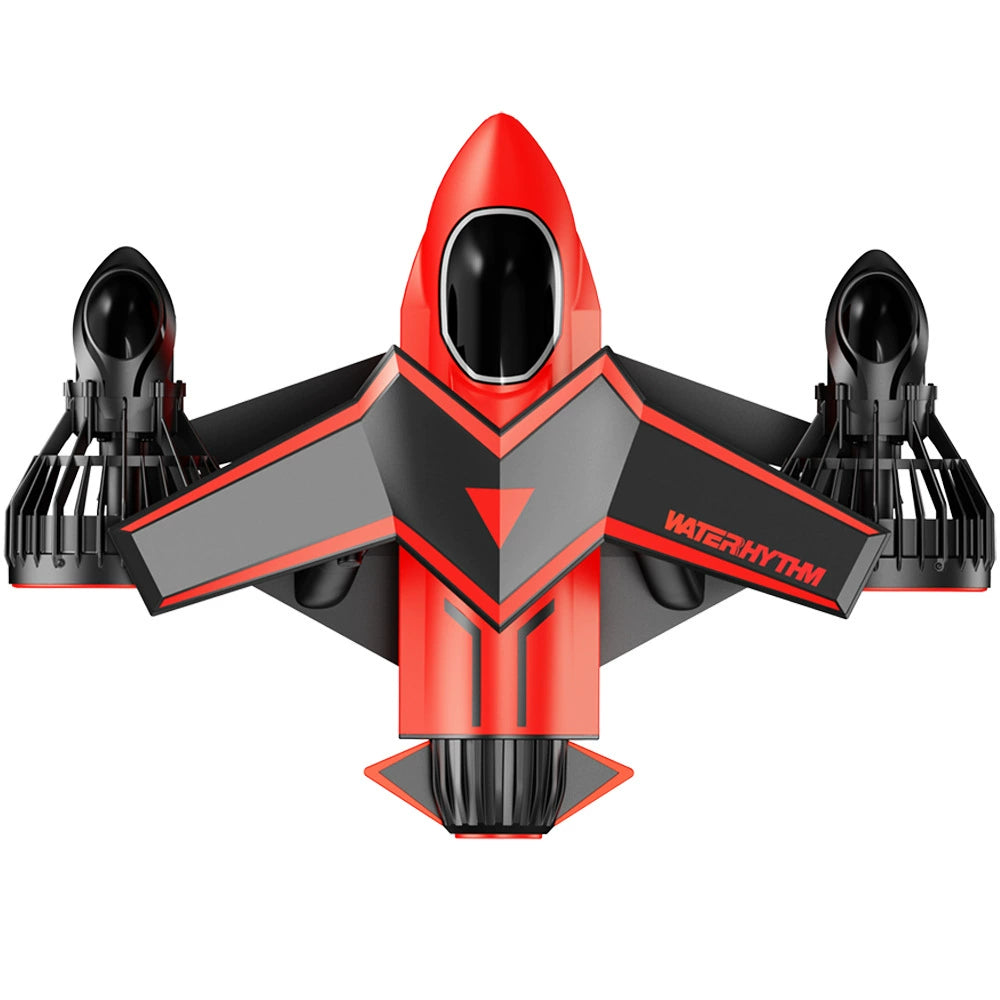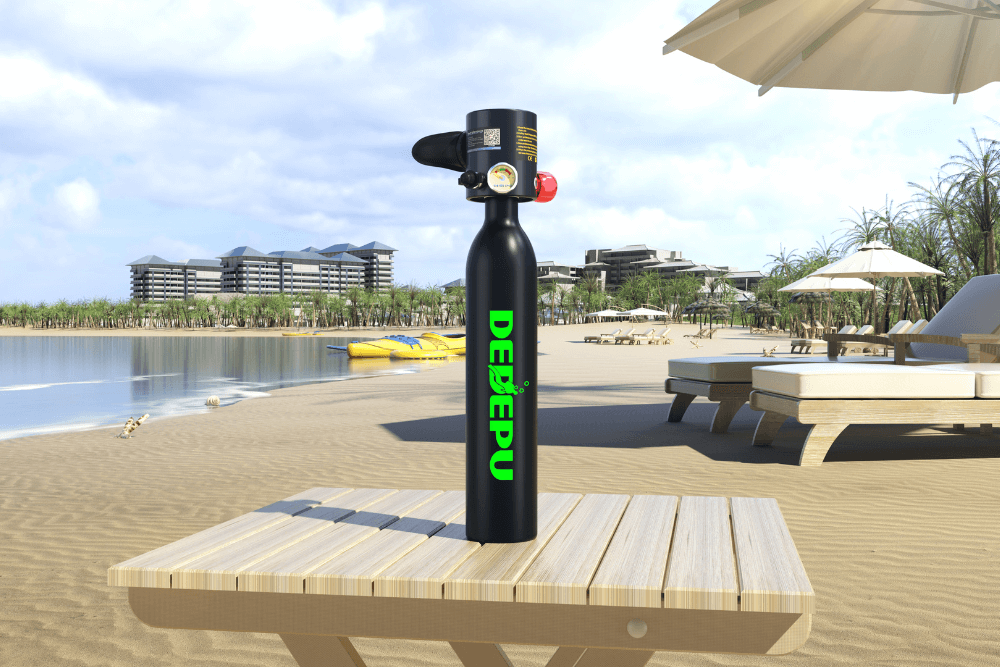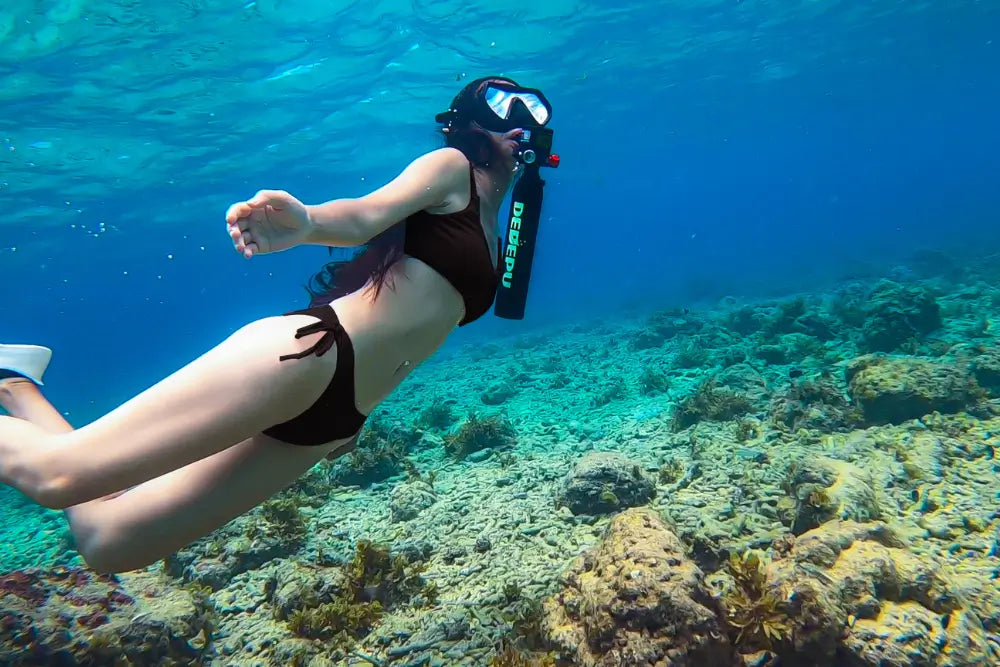Standard scuba tanks are typically filled with filtered, compressed air matching the composition we breathe: roughly 78% nitrogen (N₂) and 21% oxygen (O₂), with about 1% other gases. For longer bottom times at shallower depths, many divers use Enriched Air Nitrox (EANx), which has a higher oxygen percentage (commonly 32% or 36% O₂, labeled EAN32 or EAN36). Importantly, the maximum operating depth (MOD) decreases as oxygen percentage increases; for example, the MOD for EAN32 is 34 meters/112 feet (using a maximum partial pressure of 1.4 bar). Before every dive, divers must personally analyze their tank's oxygen percentage with a calibrated analyzer and match their planned depth to the gas mix. Tanks undergo mandatory visual inspections annually and hydrostatic testing every 5 years to ensure structural integrity under high pressure (often rated at 200 bar or 300 bar). Always fill tanks at reputable stations using specialized compressors with proper filtration systems.
Scuba Tank Basics
A scuba tank’s primary function is storing compressed breathing gas – typically 12 liters (L) to 18L in volume – at pressures ranging from 200 to 300 bar (2,900–4,350 psi). Constructed from aluminum alloys (like AL-6061-T6, 3.0–3.5 kg empty weight) or chromoly steel (thinner walls, weight savings of ~1.5 kg vs. aluminum), it supplies air for 40–60 minutes at recreational depths (10–20 meters). Tanks maintain safe breathing via first-stage regulators that reduce tank pressure to intermediate pressure (8–12 bar). Hydrostatic testing every 5 years and annual visual inspections ensure integrity against fatigue stress and corrosion pits >2.5mm deep. Capacity hinges on internal volume × pressure: a 12L tank at 200 bar holds 2,400 liters of gas.
Scuba tanks convert high-pressure gas (stored at 200–300 bar) into breathable air through a two-stage regulator system; the first stage reduces tank pressure to intermediate pressure (10±2 bar), while the second stage delivers it on demand at ambient water pressure ±0.5 bar. Tank efficiency is defined by gas volume (liters) = tank volume (L) × fill pressure (bar) – meaning a standard 15.5L aluminum tank at 230 bar contains 3,565 liters of gas. For a diver consuming 30 liters per minute (L/min) at 10 meters depth (where ambient pressure is 2 bar absolute), this provides approximately 50–60 minutes of bottom time before reaching the reserve pressure threshold (50 bar). Steel tanks offer 15–20% greater gas capacity than aluminum at identical external sizes due to thinner walls (e.g., 3.8mm vs. 5.7mm), translating to weight reductions of ~1.2–1.8 kg per tank and ~1.8 kg less lead needed for neutral buoyancy.
Aluminum tanks (dominant in the US) comply with DOT/ISO SP6491 standards, with wall thicknesses between 5.0–7.3mm, while European chromoly steel tanks (EN ISO 11120) use thinner 2.8–4.5mm walls treated to resist corrosion via hot-dip galvanizing or internal epoxy coating. Each tank undergoes destructive testing during certification to ensure rupture pressures exceed 1.67× working pressure (e.g., 500 bar burst for a 300 bar tank). Mandatory hydrostatic tests (every 5 years) measure elastic expansion/recovery rates to detect micro-cracks; tanks failing expansion tolerances beyond 10% permanent stretch are condemned. Annual visual inspections focus on thread integrity (≥99% thread engagement) and internal/external corrosion pits not exceeding 2.54mm depth or occupying >5% of total surface area. Valve service intervals (every 24 months) replace burst discs rated to burst at 312–330 bar (for 232-bar tanks).
Tank cost scales with material and certification: a new aluminum 80-cuft (11.1L) tank averages 220–280 USD, while steel HP-100 (13.1L) tanks cost 350–450 USD. Lifespan ranges from 20 years (aluminum) to 30+ years (steel) with proper maintenance. Fill costs vary by location (~5–15 USD), impacted by gas mixtures: filling with Enriched Air Nitrox (32–36% O₂) adds 5–8 per fill for O₂ cleaning and O₂ analysis fees. Weight/ballast tradeoffs are critical: aluminum tanks shift from negative buoyancy (1.0–1.3 kg when empty) to positive buoyancy (≈1.8 kg when full)–requiring 2–4 kg additional weights–whereas steel tanks remain negatively buoyant (e.g., HP-130: -2.7 kg full, -1.5 kg empty), reducing overall weight burden. Common sizes balance portability and dive duration: compact 7L pony bottles (backup gas), 11.1L (80 cu ft) recreational tanks, and 15.5–18.2L (120–130 cu ft) technical tanks for extended depths.

Common Gas Mixtures Explained
Scuba tanks primarily hold filtered dry air, which consists of 78.08% nitrogen (N₂) and 20.95% oxygen (O₂), with trace gases (argon, CO₂) making up the remaining 0.97%. For extended dives, Enriched Air Nitrox (EANx) increases O₂ levels to 32% (EAN32) or 36% (EAN36), reducing nitrogen absorption by ~17% per 10% O₂ increase versus air. Technical divers use trimix blends (e.g., 21/35: 21% O₂, 35% helium, 44% N₂) to combat nitrogen narcosis below 50 meters. Gas fills require strict moisture control (≤-45°F dew point) and filtration to 0.01-micron purity, ensuring breathing safety at pressures exceeding 200 bar.
① Standard Air: Composition and Depth Limits
The default gas for recreational diving is compressed atmospheric air, with oxygen concentration fixed at 20.95±0.5% and nitrogen at 78.08±0.5%, delivering reliable performance down to 40 meters before narcosis risks escalate (equivalent to 4–5 martinis at 50m). Partial pressure governs toxicity: the oxygen exposure limit of 1.4 bar pO₂ caps maximum operating depth (MOD) for air at 56.7 meters (calculated as MOD = (1.4 / 0.2095) − 1 × 10 meters), while nitrogen’s narcotic potency peaks at depths exceeding 30 meters where alveolar N₂ partial pressure surpasses 3.2 bar. Air fills cost 5–12 USD per tank due to simple filtration requirements using activated alumina desiccants and carbon towers that strip hydrocarbons to 0.1 mg/m³ levels.
② Enriched Air Nitrox (EANx): Oxygen Boosts and Calculations
EANx mixtures boost oxygen to 22–40% (typically 32% or 36%), directly reducing nitrogen intake and extending no-decompression limits (N² load drops 30% at 24m on EAN32 vs. air). Critical constraints apply: higher O₂ increases toxicity hazards, capping EAN32’s MOD at 34 meters (pO₂ max = 1.4 bar ÷ 0.32 = 4.375 ATA → 33.75m), while EAN36 hits its 29.3-meter MOD faster. Blending requires batch testing with ±0.25% O₂ analyzer accuracy, backed by continuous-fill membrane systems or partial-pressure mixing costing 8–20 per fill (including O₂-cleaned valves and O-rings). Divers log gas exposure using OTU (Oxygen Tolerance Unit) limits: 850 OTUs/day prevents pulmonary damage during repetitive dives (e.g., 60 mins at 15m on EAN32 = ≈45 OTUs).
③ Trimix and Technical Gas Logistics
For dives beyond 50 meters, helium replaces nitrogen in trimix blends, slashing narcosis risks (helium’s narcotic potency is 4.26x lower than nitrogen) while improving thermal conductivity (6x faster heat loss requires heated suits). Common blends like 18/45 (18% O₂, 45% helium, 37% N₂) or hypoxic 10/70 enable descents to 80+ meters – MOD calculations must account for hypoxic blackout risks above 5m if O₂ falls below 16%. Helium costs dominate fills (2–4 USD per cubic foot, driving trimix fill fees to 120–400 per tank), with blending requiring ±1% mixture accuracy using digital pressure sensors monitoring fill gradients in 10-bar increments. Shelf life concerns arise: helium permeation through tank walls occurs at 0.1–0.3% per month, requiring requalification testing every 90 days for stored gas.
④ Purity Standards and Contamination Thresholds
All gases must meet ISO 8573-1 Class 1 standards: oil aerosols ≤0.01 mg/m³, particulates ≤0.1 micron, and moisture controlled to −65°F dew point. Carbon monoxide (CO) – a lethal contaminant from compressor faults – is capped at 5 ppm (10 ppm triggers mandatory system shutdown), while CO₂ levels must not exceed 500 ppm. Contamination testing uses FTIR spectrometers sampling at 10-second intervals, with fills invalidated if O₂ concentration drifts ±1% from target. Valves for O₂-rich gases (>23%) require UL- and CE-compliant burst discs rated to ±5% pressure tolerance, alongside non-greased chromed-brass fittings resisting ignition above 25 bar flow rates.
Types of Tank Gases
Recreational divers typically use filtered air costing 15 per fill, but specialized gases like Enriched Air Nitrox (EAN32/36) – commanding 25 per fill due to O₂ cleaning fees – extend bottom times by 20–40% at 18–30m depths. Technical divers opt for trimix (500 fills) blending helium (45–70%) to suppress nitrogen narcosis below 60m. Less common options include pure O₂ for decompression (max depth 6m) and argon for drysuit inflation (thermal conductivity 68% lower than air), each requiring specific tank preparations like O₂-compatible lubricants ($50 valve service cost).
① Standard Compressed Air
Most dives operate on dry air blends with O₂ fixed at 20.95±0.5% and impurities capped: CO ≤5 ppm, CO₂ ≤500 ppm, and moisture controlled to dew point ≤−45°F. Filtration systems use activated alumina beds (600 replacement cost every 2,000 fills) and particulate filters trapping 0.01-micron contaminants. At 15m depth, air supports safe no-decompression limits (NDLs) of 60 mins, with consumption rates averaging 25–30 L/min during moderate exertion. Annual operating costs per tank total ≈45 hydro tests and $20 visual inspections).
② Enriched Air Nitrox
EANx blends (EAN32/EAN36) require continuous blending systems (30,000 equipment investment) achieving mixture accuracy ±0.25%, with fill costs elevated by 8 O₂ surcharge. Dives at 20m on EAN32 extend NDLs to 75 mins (vs. 45 mins on air) – a 67% bottom-time gain – while reducing nitrogen absorption by 31%. Precise handling demands semi-annual valve service (22 per set) and copper-free lubricants. Tank cleaning for >23% O₂ uses $120 USD/quart solvents and ultrasonic baths removing hydrocarbon residues to <0.1 mg/m³.
③ Technical Mixes
Trimix blends (e.g., TMX 18/45: 18% O₂, 45% He, 37% N₂) permit dives to 80m+ where helium slashes nitrogen narcosis potency by 4.26x, but costs soar: helium fills at 4.00 USD/cu ft consume 70–100 cu ft per dive, raising fill prices to 400. Helium’s low molecular weight increases flow rates by 2.8x, requiring specialized metal-seated valves (350 each) rated for 300–350 bar. Hypoxic blends (<12% O₂) demand staged gas switching below 12m to avoid hypoxia, with gas monitoring ensuring ±1% mixture stability via infrared analyzers (3,500 per unit).
④ Specialty Gases
Pure O₂ (99.5%+ purity): Used for decompression stops at 6m max depth, rapidly flushing nitrogen at 3.1x air’s efficiency. Tank prep costs reach 22–$30 per fill).
Argon (≥99.995%): Dry suit inflation gas leveraging its low thermal conductivity (0.016 W/m·K vs. air’s 0.026 W/m·K), reducing heat loss by 38%. 3L bottles (16 per refill).
Gas Comparison Metrics
| Gas Type | Typical Blend | Cost/Fill (USD) | MOD (m) | NDL at 30m (min) |
| Standard Air | 21% O₂/79% N₂ | 5–15 | 56.7 | 20 |
| EAN32 | 32% O₂/68% N₂ | 12–25 | 34 | 40 |
| TMX 18/45 | 18% O₂/45% He | 280–400 | 90 | 15 |
| Pure O₂ | >99.5% O₂ | 22–30 | 6 | Not applicable |
Choosing and Using Your Tank Effectively
Selecting the right scuba tank balances capacity, weight, and gas needs. Aluminum tanks (11.1L/80 cu ft) weigh 14.5 kg (31.9 lbs) full, costing 220–280 USD, while steel 12L (100 cu ft) tanks are 20% heavier but offer 15% more gas capacity and negative buoyancy (–1.5 kg full) saving 1.8 kg of lead weights. For warm-water dives ≤25m, a single 80-cuft tank provides 50–55 mins at 20 L/min SAC rate. Cold-water technical dives require dual 12L/232-bar steel tanks (850/set)with45–60minbottomtimeat40m.Hydrotestingevery5yearsadds45–$65 USD/tank.
Material & Capacity Selection
Aluminum tanks (e.g., AL80: 11.1L volume, 206 bar working pressure) are 32% cheaper (240avg)thansteeltanksbutfloat+1.7kgwhenempty,demanding2–4kgextraleadthatincreasesdragandairconsumptionby≈8380–500USD/tankandrequiresannualinternalcoatingstopreventcorrosionat>7535/year maintenance. For divers with SAC rates >25 L/min, tanks below 10L capacity (e.g., AL63: 7.4L) deplete in ≤35 mins at 18m – forcing shorter dives or requiring redundant systems.
Dimensions and Handling Costs
Standard 80 cu ft aluminum tanks measure 66 cm height × 20.3 cm diameter and weigh 16.8 kg full, while compact steel cylinders (HP80: 10.2L) shrink to 58 cm × 18.4 cm but maintain 2,856L gas capacity. Airline baggage fees impact travel costs: tanks exceeding 22.7 kg (50 lbs) incur 75–200USDoversizefees,making<15kgemptytankseconomicallypreferableforfly−and−divetrips.Rentaltankavailabilitypeaksat80–100cuftsizes(≈8510–15/dayvs.25–$30/day for technical twinsets. Surface intervals between repetitive dives should exceed 1.5 hours to limit nitrogen residues to <45% saturation, enabled by tanks filled to <40°C temperature to prevent pressure drops from cooling.
Gas Management & Valve Protocols
Begin each dive by verifying fill pressure within ±5% of rated capacity (e.g., 225 bar for 232-bar tanks) and analyzing O₂ percentage for nitrox with ±0.5% analyzer tolerance. Air consumption should be tracked against depth: at 30m (4 ATA), consumption multiplies by 4x surface rate – a diver averaging 20 L/min on surface will use 80 L/min here. Reserve gas planning must allocate ≥50 bar or 500 psi for ascent and safety stops, plus additional 35% for emergencies; thus, a 3,000L fill allows 1,950L usable gas (65%). Valve opening requires full-counterclockwise rotation until seated to ensure 45 L/min flow at 50m, while partial opening causes flow restrictions >60% risking hypoxia during high exertion. Post-dive, tanks must be stored with 50–80 bar pressure to block moisture intrusion exceeding 5% humidity content – a leading cause of internal corrosion reducing tank lifespan by ≥7 years.
Cost per Dive Analysis
Tank longevity spans 20–30 years with proper care: annual visual inspections (20–35USD)detectthreadcorrosionexceeding0.5mmdepth,whilehydrostatictestsevery5years(45–65 USD) enforce ≤10% permanent expansion limits. Valves demand biennial servicing (55–75USD)replacingburstdiscsratedat110–150440 USD in testing/inspection costs over 600 dives – ≈0.73/diveplus6.50/fill. Choosing steel tanks raises initial investment 25% but cuts lifetime costs by 15% due to lower buoyancy weight fees and extended 30-year serviceability. Divers logging <20 dives/year save 38% with rentals vs. ownership.
Tank Selection Guide by Dive Profile
| Dive Type | Recommended Tank | Capacity (L) | Avg. Cost (USD) | Max. Depth | Bottom Time |
| Recreational | Aluminum 80 cu ft | 11.1 | $250 | 40m | 45 min |
| Warm Water | Steel HP100 | 13.1 | $420 | 30m | 65 min |
| Cold Water | Dual Steel 12L (232 bar) | 24.0 | $850+ | 50m | 35 min |
| Technical Deco | Dual LP104 + Stage 80 cu ft | 32.4+11.1 | $1,300+ | 70m | 25 min |
| At 20m depth with 20 L/min SAC rate |
Regular Tank Care
Scuba tanks require annual visual inspections (25–40 USD per service) and hydrostatic testing every 5 years (50–70 USD per test) to maintain certification. Technicians measure internal corrosion pits exceeding 0.5mm depth or covering >10% of the surface, conditions that condemn 3.8% of aluminum tanks and 1.2% of steel tanks annually. Valve maintenance every 2 years (60–85 USD) replaces burst discs rated to 110–150% working pressure (e.g., 345 bar disc for 230-bar tanks). Proper storage requires 50–70 bar residual pressure to prevent moisture intrusion above 45% humidity – a key factor preventing internal corrosion that reduces tank lifespan by ≤9 years.
① Visual Inspection Metrics & Condemnation Criteria
During annual checks, technicians scrutinize tanks using borescopes with 0.4–2.0mm resolution to quantify defects: corrosion pits deeper than 0.5mm (equivalent to 15% wall thickness loss in aluminum) or spanning >30mm diameter are automatic fail points, while thread damage exceeding 15% tooth deformation or exhibiting cracks >2mm long requires valve replacement. External inspection uses ultrasonic thickness gauges measuring ±0.01mm precision to flag wall erosion below 3.5mm in aluminum (11.4% minimum) or 2.8mm in steel (9.7% minimum). Statistics show 17% of tanks need bead blasting (45–80 USD) to remove oxidation exceeding 25g/m² mass gain, with condemned cylinders representing ≤5.2% of inspections – most commonly older aluminum tanks with 12+ years service.
② Hydrostatic Testing Physics & Pass/Fail Thresholds
Hydro tests submerge tanks in 8,000–10,000 psi water pressure (measured within ±1% accuracy) for 120 seconds, monitoring expansion: acceptable elastic expansion must not exceed 10.0% of total volumetric growth (e.g., 12.8L aluminum tank expanding ≤1.28L), while permanent expansion ≥10.1% fails certification. Test equipment records strain rates ≥1 microstrain/sec to detect microcracks, rejecting tanks showing >3% deviation from baseline elasticity. Post-test drying cycles reduce internal moisture to ≤-45°F dew point using 12 CFM air flows for 90 seconds. Refill pressure tolerances are capped at ±3% of rated capacity (e.g., 230±7 bar), with 7.8% of tested tanks requiring requalification due to valve seat leaks exceeding 1 bubble/5 seconds during soap solution immersion.
③ Valve & Thread Maintenance: Component Service Intervals
Valves demand biennial disassembly replacing Teflon stem seals (18USDperset),brass−coreburstdiscs(12–25 USD), and Viton O-rings (9USD)whileverifyingstemtorquesettingsof25–35N⋅mtopreventcreepfailure.ThreadinspectioninvolvesGO/NO−GOgaugesassessingwear:NO−GOgaugeengagement>1.5threadstriggersre−tappingat150–280USDcost.Regulatorinterfacepressuresarecalibratedtodeliver10.5±0.5barintermediatepressureat230bartankpressure,withdeviations>895 USD/gallon concentration) removing ≥99% hydrocarbons from O₂-service valves within 22-minute cycles.
④ Storage, Handling & Longevity Economics
Store tanks upright with min 50 bar residual pressure in environments maintaining 30–50% humidity; humidity >55% RH accelerates corrosion rates by 17.3%/year, reducing 20-year aluminum tank lifespan to 12–14 years. Avoid temperature swings >20°C/day – common in uninsulated garages – which cause wall stress fatigue lowering burst pressure tolerance by ≤14%. Transport requires impact-resistant boot rings (38–70 USD) absorbing ≥50 J collision energy. Across a 15-year lifespan, maintenance averages 400USDperaluminumtank(26.67/year) versus 530USDforsteel(35.33/year), with negligence increasing failure probability: tanks skipping >2 visual inspections show 4.9x higher hydro-test rejection rates.
Maintenance Cost & Frequency Matrix
| Procedure | Frequency | Avg. Cost (USD) | Critical Metrics |
| Visual Inspection | 12 months | 32.50±7 | Pit depth <0.5mm; Corrosion <10% area |
| Hydrostatic Test | 60 months | 60±10 | Permanent expansion <10% |
| Valve Service | 24 months | 72.50±12.50 | Burst disc rating ±5% tolerance |
| Internal Cleaning | 24–36 months | 55–120 | Hydrocarbon residue <0.1 mg/m³ |
| Tank Boot Replacement | After impacts | 45–85 | Impact resistance ≥40 J |






Leave a comment
All comments are moderated before being published.
Situs ini dilindungi oleh hCaptcha dan berlaku Kebijakan Privasi serta Ketentuan Layanan hCaptcha.